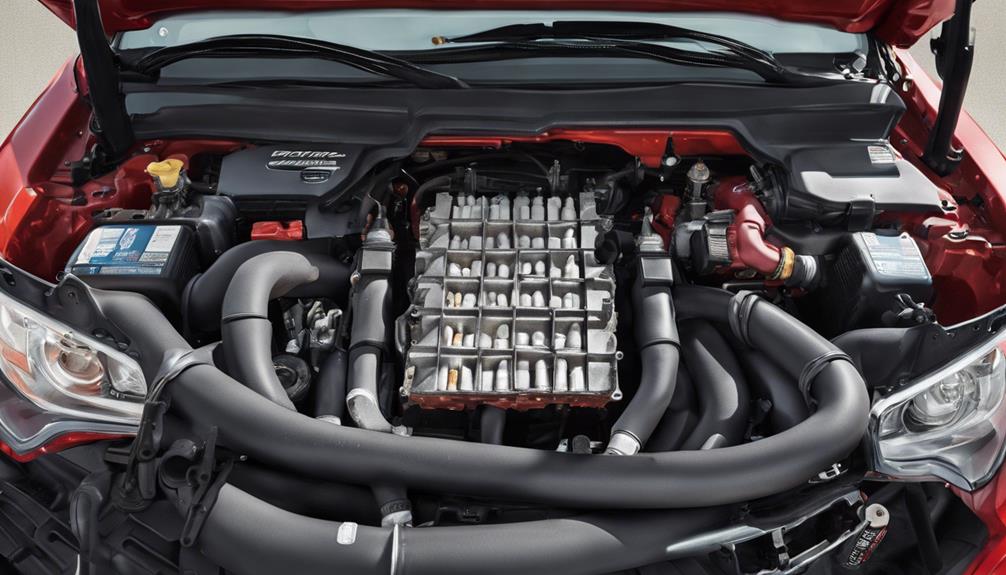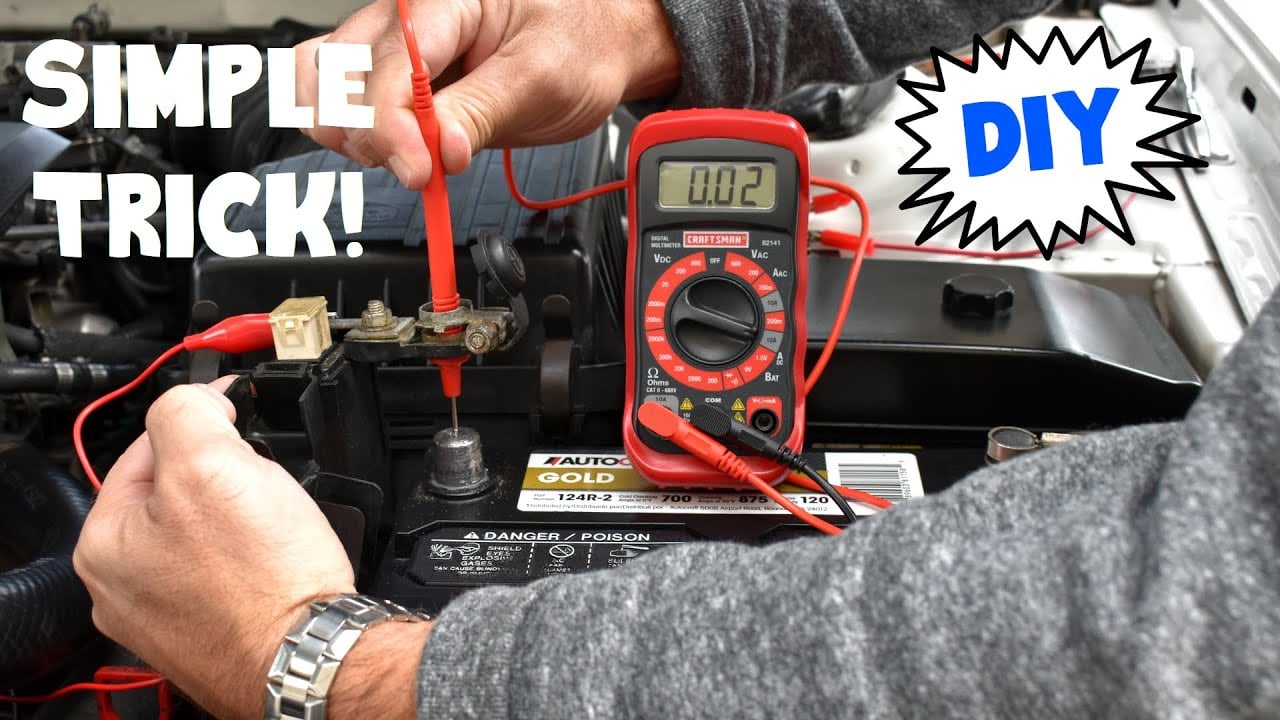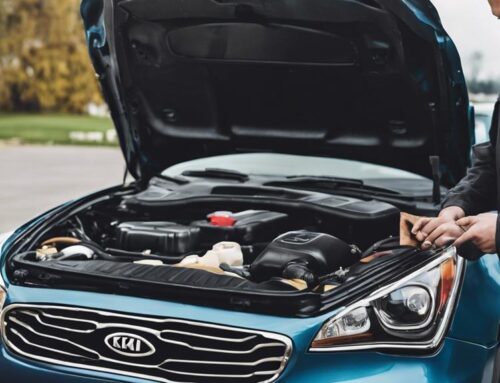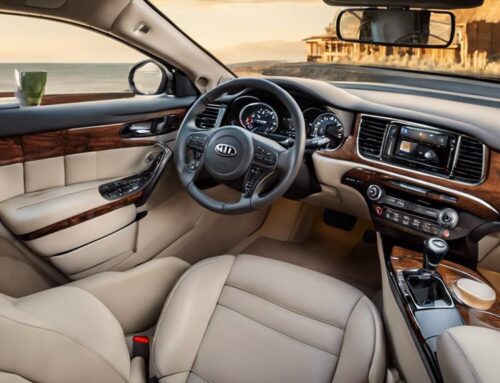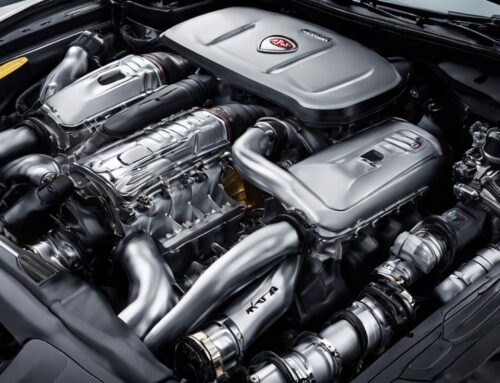Common Toyota Tundra ignition issues typically involve battery-related problems, electrical system malfunctions, or engine ground and starter wiring issues. You might experience starting difficulties, such as no crank conditions, which can be traced back to a faulty ignition switch or weak battery connections. Additionally, poor connections and blown fuses can disrupt the electrical flow. Regularly cleaning and tightening battery terminals and inspecting the security system can help prevent these issues. Ensuring secure jumper cable connections and checking for corrosion on terminals can also aid in smooth operation. There's more to uncover about troubleshooting these problems.
Key Takeaways
- Failing battery causing ignition problems.
- Loose or corroded battery connections disrupting electrical flow.
- Faulty ignition switch leading to intermittent starting issues.
- Electrical system malfunctions, including solenoid clicking and slow cranking.
- Corroded or loose engine ground wires affecting ignition reliability.
Battery-Related Problems
When facing ignition issues with your Toyota Tundra, one of the first areas to check is the battery. Start by testing your battery at full charge using a load test to see if it holds up under stress. This step is important because a battery can appear fully charged but still fail under load, causing ignition problems.
Next, inspect the battery connections. Make sure they're clean and tight. Corroded or loose connections can disrupt the electrical flow, leading to starting issues. Use a wire brush or terminal cleaner to remove any corrosion, and retighten the connections if needed.
Using a voltmeter, test the battery to confirm that the voltage levels meet your Tundra's operational requirements. A healthy battery should typically read around 12.6 volts or higher when fully charged. If the voltage is low, it might not provide enough power to start your vehicle.
Also, check that all cable connections, including the positive and negative terminals, are securely fastened. Loose cables can cause intermittent electrical issues, making your Tundra unreliable.
Electrical System Malfunctions
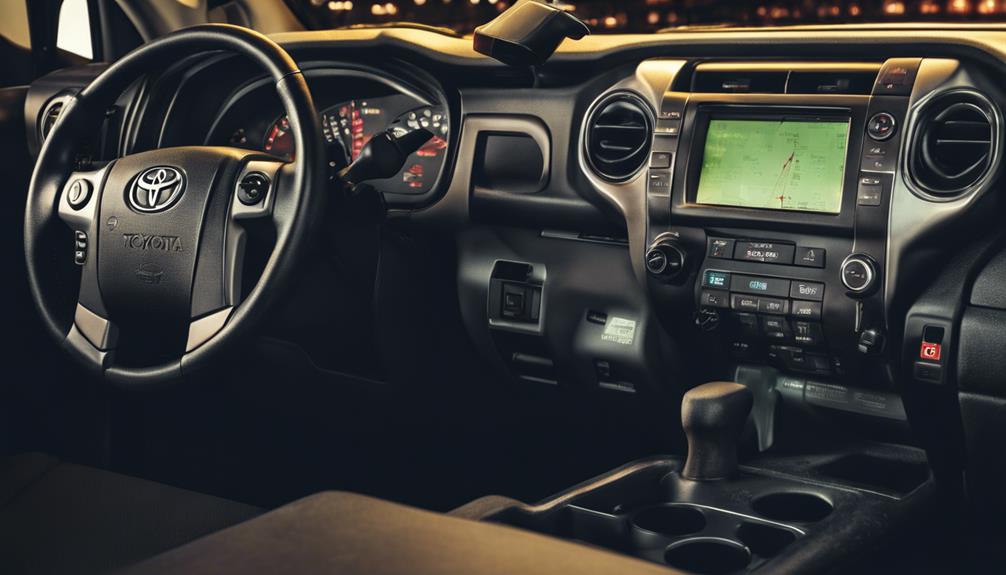
After confirming that your battery is in good condition, you should next examine the electrical system for malfunctions that could be causing ignition issues in your Toyota Tundra. Electrical system problems can lead to intermittent starting issues, which might leave you stuck at the most inconvenient times. You might notice symptoms like the solenoid clicking, slow cranking, or trouble starting when you turn the key to the 'ON' position. These signs point towards potential issues within the electrical components.
A faulty ignition switch is often the culprit and can impact the starter relay, severely affecting starting performance. Additionally, the theft deterrent system wiring within the ignition switch can contribute to starting problems. This system is designed to prevent theft but, when malfunctioning, it could prevent your vehicle from starting altogether.
To regain control over your Tundra, proper diagnosis and troubleshooting of these electrical components are essential. Check the ignition switch, starter relay, and the relevant wiring to ensure everything is functioning correctly. By addressing these electrical malfunctions, you can resolve many starting issues and keep your Toyota Tundra running smoothly.
Engine Ground Issues
A bad engine ground can cause significant starting problems in your Toyota Tundra. Ensuring a solid engine ground connection is essential for reliable ignition. If the ground wires are corroded or loose, you might experience intermittent starting issues that can be both frustrating and unpredictable.
You'll want to check the engine ground's integrity as a key step in diagnosing any ignition problems. Locate the engine ground wire and inspect it thoroughly. Look for any signs of corrosion, wear, or looseness. Cleaning any corrosion and tightening the connections can often resolve starting issues immediately. A solid ground connection ensures the electrical system can perform efficiently, providing the necessary power to start your engine.
Starter Wiring Problems
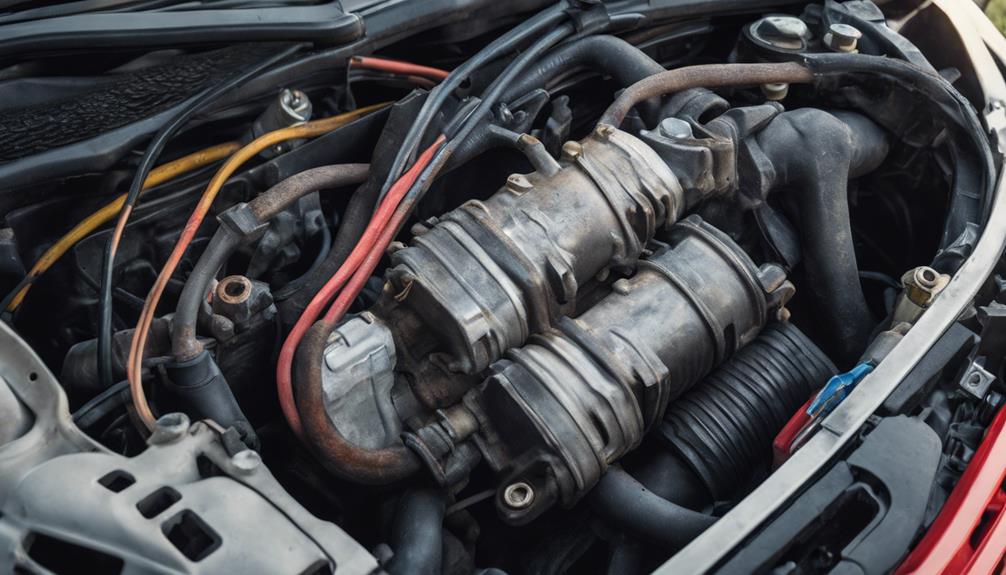
You might encounter starter wiring problems causing your Tundra's intermittent starting issues. Faulty wiring connections and corrosion can disrupt the direct current path, leading to slow cranking or solenoid clicking. Addressing these connections and inspecting for wear can help maintain reliable starting performance.
Faulty Wiring Connections
Inconsistent starting in your Toyota Tundra often stems from faulty wiring connections in the starter system. These issues commonly occur in V8 models, where corroded or loose wiring can disrupt the flow of electricity to the starter. When the electrical connection isn't solid, you'll likely experience intermittent starting problems that can be both frustrating and inconvenient.
You'll want to address these wiring issues promptly to avoid more severe ignition problems down the line. Start by inspecting the wiring connections to the starter. Look for any signs of corrosion or looseness. Cleaning these connections and ensuring they are tight can make a significant difference. If the connections are bad, you might notice slow cranking, solenoid clicking, or even difficulty starting the engine altogether.
Corrosion and Wear
Have you ever noticed how corrosion and wear on starter wiring can wreak havoc on your Toyota Tundra's ignition system? Corroded wiring leads to poor electrical connections, which can severely impact your starter's performance. When the connection isn't essential, your Tundra might struggle to start or refuse to start altogether, leaving you frustrated and stranded.
Wear on starter wiring can be just as problematic. Over time, the wiring deteriorates, causing intermittent starting issues. You might find your Tundra starting perfectly one day and refusing to turn over the next. This unpredictability can be a major inconvenience, especially if you rely on your vehicle daily.
To maintain control over your vehicle's reliability, it's important to clean and inspect the starter wiring regularly. Look for any signs of corrosion, like a white or greenish-blue powdery substance, and address it promptly. By doing so, you're not only preventing ignition problems but also improving the overall reliability of your Tundra's ignition system.
Addressing these issues proactively ensures your Tundra remains dependable. By staying on top of corrosion and wear, you're taking a significant step toward maintaining the performance and longevity of your vehicle.
Starting Difficulties
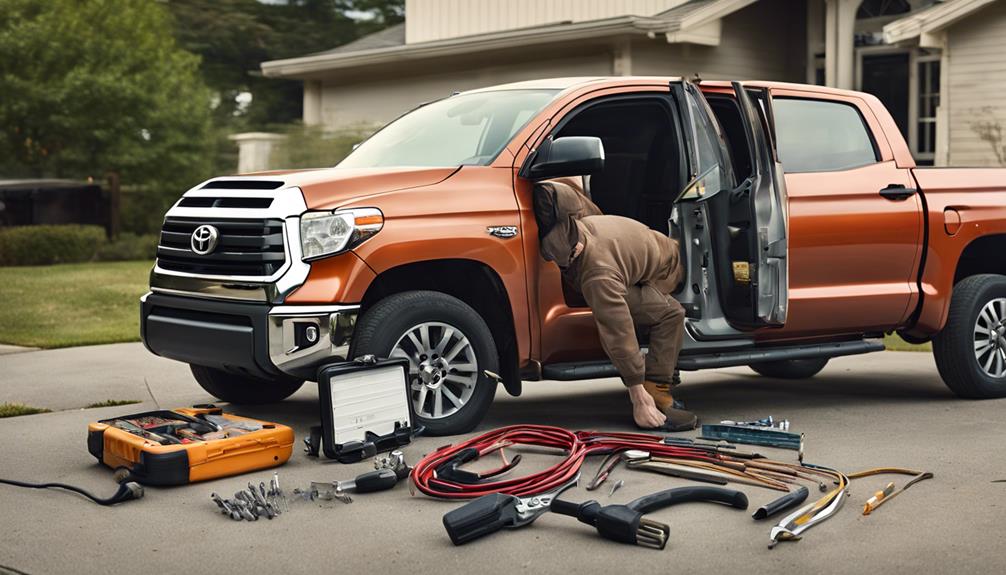
When your Toyota Tundra struggles to start, a faulty ignition switch or weak battery connections could be the culprits. Turning the key quickly often helps, but persistent issues might indicate deeper problems. Checking the ignition switch and ensuring strong battery connections can save you from frustrating starting troubles.
Faulty Ignition Switch
A faulty ignition switch in your Toyota Tundra can lead to frustrating intermittent starting issues. You might notice symptoms like a solenoid clicking or slow cranking when you turn the key to the 'ON' position. These signs are clear indicators that your ignition switch is causing problems. If you turn the ignition key quickly after inserting it, you'll find it works about 80% of the time. However, this isn't a sustainable solution.
The main issue lies in how the ignition switch affects the starter relay's performance. The direct current path through the ignition switch is critical. When it's compromised, you'll experience starting problems. Here's a quick breakdown of what you might encounter:
| Symptom | Description | Success Rate |
|---|---|---|
| Solenoid Clicking | Audible click, but engine doesn't start | Low |
| Slow Cranking | Engine turns over slowly | Moderate |
| Quick Key Turn Success | Quick key turn improves start chances | 80% |
| Starter Relay Performance | Erratic due to faulty ignition switch | Variable |
Weak Battery Connections
While a faulty ignition switch can cause starting problems, weak battery connections are another common culprit in your Toyota Tundra. If you've experienced intermittent starting issues, it's worth checking your battery connections. Weak or corroded connections can lead to slow cranking or even just a single click when you turn the key.
To troubleshoot, start by inspecting the battery terminals. Dirty or loose connections can disrupt the electrical flow necessary for your starter to function properly. Clean the terminals with a wire brush and tighten them to make sure a secure connection. This simple step can often resolve starting difficulties and restore your vehicle's reliability.
Don't underestimate the importance of maintaining clean and tight battery connections. Addressing weak connections promptly can prevent prolonged starting issues and potential damage to your starter. Taking control of this maintenance task can save you time and frustration in the long run.
Security System Concerns
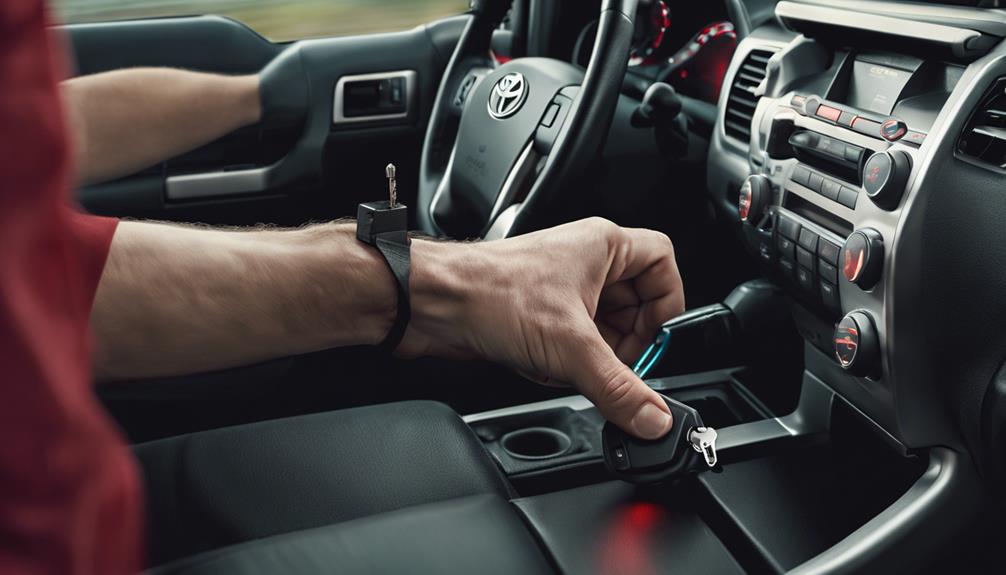
The security system in your Toyota Tundra can often prevent the truck from starting if there's an issue with its connections or components. Corrosion on these connections is a common culprit, leading to failures that might leave you stranded. You want control over your vehicle, so it's important to systematically troubleshoot any problems with the security system.
Start by inspecting the connections for any signs of corrosion or damage. Clean the terminals if needed and make sure they are tightly secured. If these steps don't resolve the issue, you may need to dig deeper into the system's components. Faulty sensors or a malfunctioning key fob could also be to blame.
If you're unable to identify the root cause, consider seeking professional assistance. A skilled technician can run diagnostic tests to pinpoint the problem. Addressing these issues promptly can prevent further complications and restore your Tundra's reliability.
Taking control of your vehicle's security system concerns not only ensures that your truck starts when you need it to but also helps maintain its overall health. Don't ignore these signs; act promptly to keep your Toyota Tundra running smoothly.
No Crank Conditions
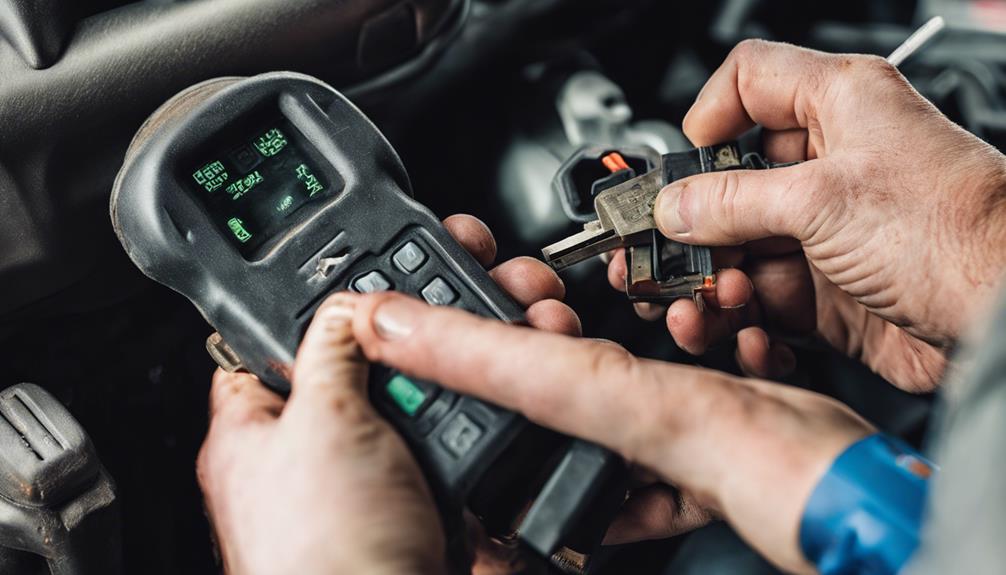
After addressing security system concerns, you might still face no crank conditions in your Toyota Tundra. These issues can be frustrating, but understanding the potential causes can help you regain control. Start by checking the battery connections to the starter. If they're loose or corroded, a vital connection might be all you need to get back on the road.
When you turn the ignition key and hear a single click or experience slow cranking, the starter relay, starter solenoid, or starter motor could be at fault. These components are essential for the ignition process, and any malfunction can prevent your engine from cranking.
Don't overlook the ignition switch or the lock-out switch, either. A bad ignition switch can disrupt the electrical pathway needed to start your vehicle, while a faulty lock-out switch can prevent the ignition from engaging altogether.
Proper diagnosis is essential. Begin with a visual inspection of connections and components, then use a multimeter to test electrical continuity. By systematically troubleshooting each component, you can pinpoint the exact cause of your no crank condition and resolve it efficiently, putting you back in control of your Toyota Tundra's ignition system.
Jump-Starting Challenges
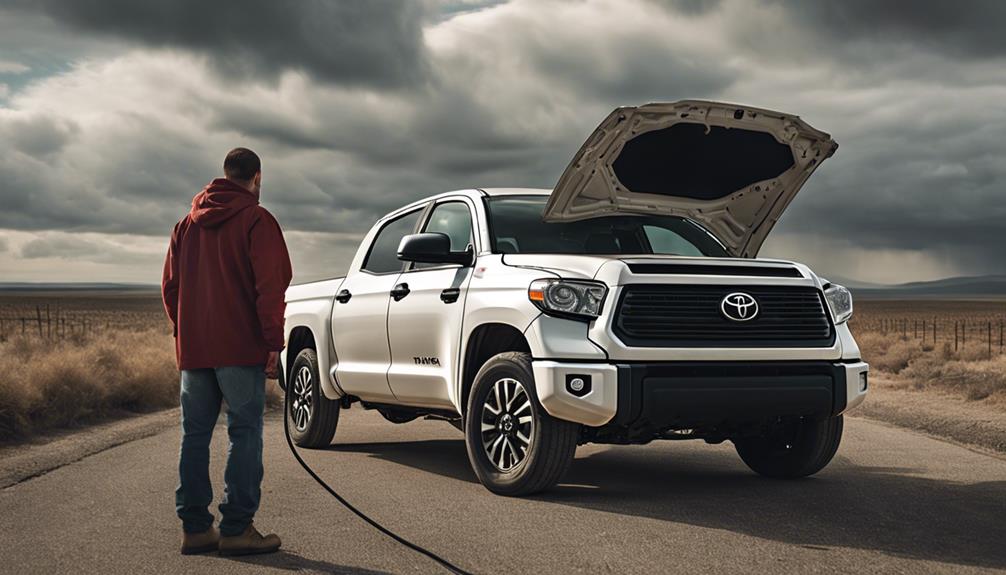
Jump-starting your Toyota Tundra can be tricky if the battery connections are corroded or loose. You need to make sure that all jumper cable connections are secure for a successful jump-start. Corroded terminals can impede the flow of electricity, making it difficult to get your truck started. To avoid these issues, regularly inspect your battery terminals. Clean any corrosion using a wire brush and a mixture of baking soda and water.
When preparing to jump-start, first confirm that the jumper cables are correctly attached to both vehicles. The red cable should connect to the positive terminal, and the black cable should go to the negative terminal on the working battery, then to an unpainted metal surface on your Tundra. This setup ensures a proper circuit and reduces the chances of sparks and damage.
Additionally, tighten any loose battery connections. Loose terminals can cause intermittent contact, leading to unreliable starts. By addressing these issues promptly, you not only improve your chances of a successful jump-start but also extend the life of your battery.
Taking these steps gives you control over your vehicle's reliability, ensuring you're not left stranded due to avoidable battery issues.
Bad Connections and Blown Fuses
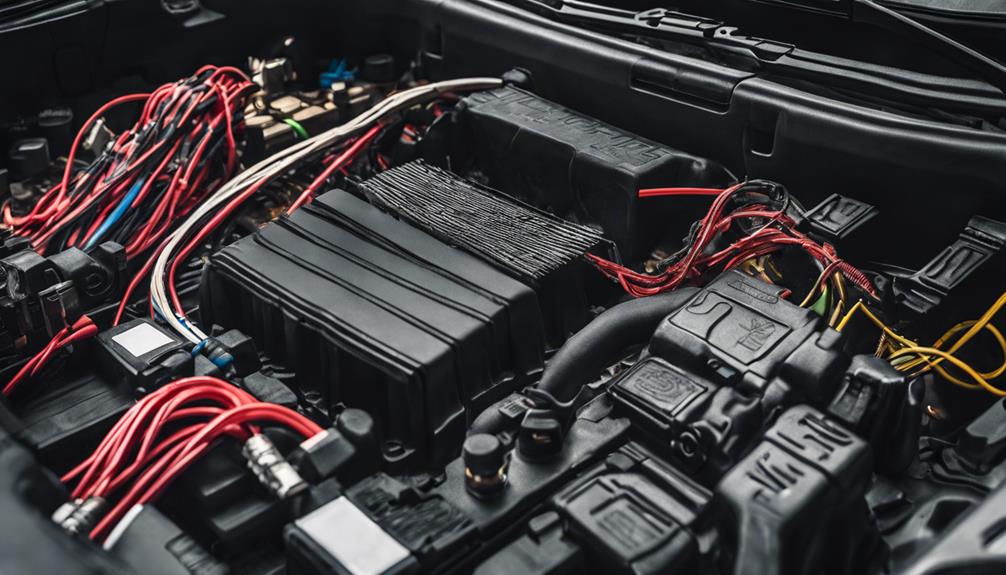
Addressing bad connections and blown fuses is just as vital as dealing with battery issues to ensure your Toyota Tundra starts reliably. Corroded or loose battery connections can cause significant problems. When the connections aren't secure, the flow of electricity can be interrupted, leading to difficulty starting your vehicle. Make sure to regularly check and clean your battery terminals, ensuring they are tightly connected and free from corrosion.
Blown fuses under the hood can also disrupt the flow of electricity to key components, affecting your Tundra's ignition system. If you turn the key and notice a lack of voltage, a blown fuse might be the culprit. To maintain control over your vehicle's reliability, periodically inspect the fuses. Replace any that appear damaged or are no longer functional.
Ensuring all electrical connections in your Toyota Tundra are intact and functional is key to preventing ignition problems. A proactive approach to maintaining these connections can save you from unexpected starting issues. By addressing bad connections and blown fuses promptly, you maintain greater control over your vehicle's performance and reliability.
Frequently Asked Questions
How Often Should I Replace the Ignition Coils in a Toyota Tundra?
Think of your Tundra's ignition coils as the heartbeat of your engine. You should replace them every 100,000 to 150,000 miles to keep your ride running smoothly. If you notice misfires, rough idling, or a drop in fuel efficiency, it's time to act. Be proactive, not reactive—replace all coils at once for consistent performance. Check your manual or consult a trusted mechanic for tailored advice. Stay in control!
Can a Faulty Ignition Switch Cause Intermittent Stalling?
Yes, a faulty ignition switch can cause intermittent stalling. When the switch fails, it disrupts the electrical flow, leading to stalling while you're driving or trouble starting your Tundra. Ignoring this issue can result in more severe problems, so it's important to diagnose and fix it promptly. Seek professional help to guarantee accurate diagnosis and repair, keeping you in control of your vehicle's performance.
What Are the Symptoms of a Failing Ignition Lock Cylinder?
You'll notice symptoms of a failing ignition lock cylinder if you have trouble turning the key, it gets stuck, or doesn't turn at all. You might find it hard to insert or remove your key, causing frustration. This issue can prevent your vehicle from starting and even lock up the steering wheel. Addressing it promptly guarantees you stay in control and avoid getting stranded or facing other driving complications.
How Do I Troubleshoot a Malfunctioning Key Fob for My Toyota Tundra?
So, you've got a malfunctioning key fob for your Toyota Tundra? First, check the key fob battery with a tester or just slap in a new one. Reprogram it using the owner's manual. Look for any physical damage on the fob. Make sure you're within range of the vehicle. If none of this works, don't hesitate—seek professional help. You're in control, and you'll get it sorted!
Can Extreme Weather Conditions Affect the Ignition System's Performance?
Extreme weather can definitely impact your ignition system's performance. In cold weather, thickening oil and decreased battery efficiency can cause slower cranking. Hot weather might degrade ignition components, leading to starting issues. High humidity could cause corrosion on electrical connections, impacting reliability. Rapid temperature changes can also stress the system. To maintain control, make sure to stay on top of regular maintenance and protect your vehicle from extreme conditions whenever possible.

